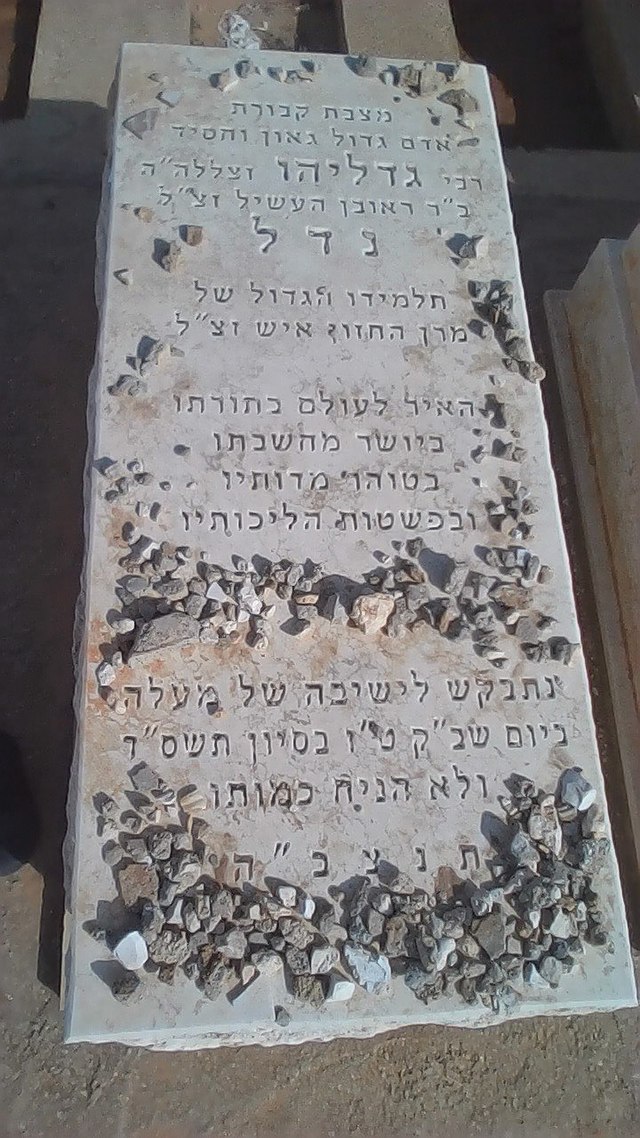Top Qs
Timeline
Chat
Perspective
Gedaliah Nadel
Israeli Haredi rabbi From Wikipedia, the free encyclopedia
Remove ads
Gedaliah Nadel (Hebrew: גדליה נדל; 1923–2004) was an influential rabbi in Israel's Haredi community, and a close disciple of the Chazon Ish. He was one of the heads of Kollel Chazon Ish and was the leading authority of Jewish Law in the Chazon Ish neighbourhood of Bnei Brak. He was an expert in all facets of Torah and Talmudic knowledge.

Remove ads
Biography
Summarize
Perspective
Nadel was born in Šiauliai, Lithuania, to Reuven Heshel and Nechama Nadel. In 1937, at age 14, he immigrated to Mandatory Palestine with his family, who settled in Balfouria, where his father received a plot of land.[1] As a child, Gedaliah was known for his diligence and devotion to studying Torah, reportedly studying for up to eighteen consecutive hours.[2] Rabbi Reuven Trop visited the settlement and suggested that Nadel’s father send him to Heichal HaTorah Yeshiva in Tel Aviv. There, under the influence of Rabbi Yehoshua Yagel, he grew close to the Chazon Ish, visiting him weekly on Fridays to discuss learning. The Chazon Ish moulded him into his principal student.[3] After completing his studies at Heichal HaTorah, he joined Lomza Yeshiva in Petah Tikva, where he studied under Rabbi Elazar Menachem Man Shach and became close to him.[4]
Rabbi Nadel married Sarah Rachel, daughter of Rabbi Eliyahu Yehoshua Weiner, a disciple of the Chofetz Chaim. After his marriage, Nadel lived in Jerusalem, close to his father-in-law, and developed connections with Rabbi Shimshon Aharon Polonsky and the Brisker Rav. Later, he moved to Bnei Brak and served as a teacher at Yeshivat Beit Yisrael v'Damasek Eliezer, affiliated with Vizhnitz Hasidism.[5]
During the 1948 Arab-Israeli War, Nadel joined the IDF, declaring it a milhemet mitzvah. However, following the Altalena Affair, he deserted, citing concerns over the leadership of the army.[6] He also sought to enlist during the Six-Day War.[7]
When the Chazon Ish decided to establish a special community of religious devotees, he chose Nadel to lead it. As the leader of the community, such leaders as Rabbi Yaakov Yisrael Kanievsky (the Steipler) and his son Rabbi Chaim Kanievsky, turned to Nadel for decisions. Nadel's house was used as a gathering place for the Rabbinic personalities of his day, such as Shach and the Steipler. After the Chazon Ish's passing, he was appointed Rosh Yeshiva at Yeshivat Beit Yisrael v'Damasek Eliezer (the Vishnitz Hasidic yeshiva), but eventually left due to disagreements with the Vizhnitz Rebbe on matters of Hasidism and zealotry. Later, he became a senior instructor at Kollel Chazon Ish, delivering private lessons from his home.
Rabbi Nadel's approach emphasized a logical and straightforward interpretation, as espoused by the Chazon Ish. He studied works generally not included in the litvak curriculum, such as Hasidic and philosophical texts. Despite his intellectual freedom, he maintained a radical and zealous stance on community issues. He abstained from voting in Israeli legislative elections and was one of the signatories against the National Service law for women.[8]
Nadel would learn Maimonides' Guide for the Perplexed immediately after praying Shacharis vatikin.[9]
In his personal life, Nadel led an austere existence, living in a modest home and avoiding luxuries. He refrained from consuming industrial products, opting instead for homemade food and privately slaughtered meat. It is said he never ate ice cream, which he saw as symbolizing indulgence. He discouraged financial dependence on Torah study, working himself as a winemaker, beekeeper, and contractor, among other trades. His homemade wine became known as "Nadel wine."
Nadel’s wife passed away in 1967 due to heart failure, while six months pregnant. The incident, involving an unauthorized autopsy by the Sheba Medical Center, led to widespread protests in Bnei Brak against post-mortem examinations, resulting in the establishment of a government commission of inquiry.[10] Rabbi Nadel was left with nine children, none of whom were married at the time.[11] He inscribed "and left no replacement" on her gravestone, expressing his sense of irreplaceable loss.
In the 1970s, he began to delve into philosophical and secular literature, developing unconventional views, such as on Judaism and evolution. He proposed that Adam the father of Seth was different from the "Adam" who fathered Cain and Abel, and accepted the scientific age of the universe, contrary to traditional creationist beliefs.[12]
Remove ads
Family
Nadel had nine children.
Writings
Summarize
Perspective
Rabbi Nadel did not publish his writings. His students compiled two volumes titled Hiddushei R’ Gedalia (Bnei Brak, 2001), and a booklet titled Shiurei R’ Gedalia. After his death, Rabbi Yitzchak Sheilat published BeTorato Shel R’ Gedalia with complete transcriptions of his teachings. The book faced opposition from his family and certain rabbis who were concerned about preserving his legacy.
B'Torato Shel Rav Gedaliah was banned by three prominent Bnei Barak rabbis because it supported Darwin's theory of evolution, including sentences such as:
"Regarding [the idea that] the creation of man in the image of God marked the end of a long process which started with a non-cognizant animal which gradually evolved until this creature was given a human mind... this is an accurate description. Darwin's proofs, and those of geologists, for the existence of early stages of mankind, seem convincing."[13]
B'Torato Shel Rav Gedaliah is a compilation of teachings prepared, which, according to the book, is taken from Nadel's audio recordings and published at his request. It was published by Rabbi Yitzchak Sheilat, one of Nadel's main students, and at the personal request of Nadel.
In 5772 (or 2010/2011 CE), Sheilat published a new edition.
Rabbi Nadel’s son-in-law, Rabbi Dovid Levi, authored several works influenced by Nadel’s teachings, including the "Derech Dovid" series on various Torah topics.
Further reading
- Eliezer Schulman, extensive article on Rabbi Nadel, Mishpacha magazine, 12 Nisan 5776, pp. 223–229
References
External links
Wikiwand - on
Seamless Wikipedia browsing. On steroids.
Remove ads

